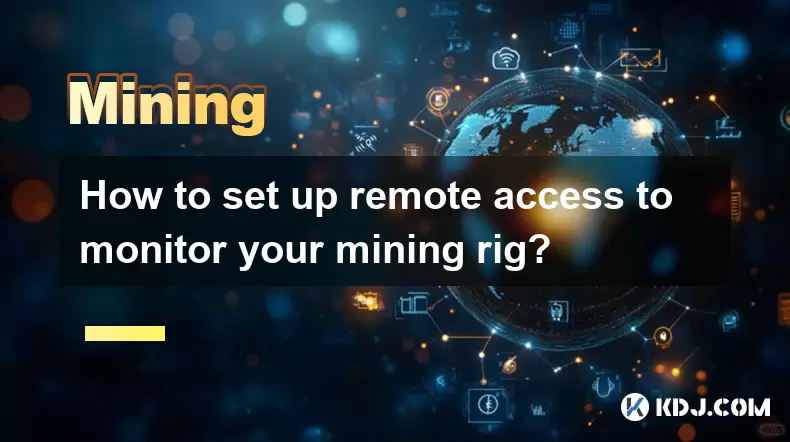-
 bitcoin
bitcoin $112195.049338 USD
2.42% -
 ethereum
ethereum $4124.915858 USD
2.81% -
 tether
tether $1.000570 USD
0.02% -
 xrp
xrp $2.861568 USD
2.25% -
 bnb
bnb $1000.346670 USD
3.04% -
 solana
solana $209.070819 USD
3.38% -
 usd-coin
usd-coin $0.999870 USD
0.02% -
 dogecoin
dogecoin $0.235379 USD
2.65% -
 tron
tron $0.335681 USD
-0.20% -
 cardano
cardano $0.803501 USD
3.38% -
 hyperliquid
hyperliquid $47.120881 USD
3.56% -
 chainlink
chainlink $21.501300 USD
3.44% -
 ethena-usde
ethena-usde $1.000571 USD
0.02% -
 avalanche
avalanche $29.793378 USD
3.62% -
 stellar
stellar $0.366964 USD
2.42%
How to set up remote access to monitor your mining rig?
Secure remote access to mining rigs enables real-time monitoring and management of hashrate, temperature, and uptime via SSH, RDP, or mining OS like HiveOS—ideal for efficient, hands-free operation.
Aug 09, 2025 at 12:29 pm

Understanding Remote Access for Mining Rigs
Remote access to a mining rig allows users to monitor and manage their cryptocurrency mining operations from any location. This capability is essential for maintaining efficiency, troubleshooting issues, and ensuring hardware remains operational without physical presence. The core idea involves connecting to the mining rig’s operating system over the internet using secure protocols. Remote access enables real-time monitoring of hashrate, temperature, power consumption, and uptime. It also supports configuration updates, software restarts, and firmware upgrades. Most mining rigs run on operating systems like Windows, Linux, or specialized mining OS such as HiveOS or RaveOS, each offering distinct methods for remote connectivity.
Choosing the Right Operating System
The choice of operating system directly impacts how remote access is configured. For example, HiveOS is purpose-built for cryptocurrency mining and includes built-in remote monitoring features accessible via a web dashboard. It supports SSH access, remote reboot, and GPU monitoring. RaveOS offers similar functionality with cloud-based control. If using a standard OS like Ubuntu Linux, SSH (Secure Shell) becomes the primary tool for remote access. On Windows, options include Remote Desktop Protocol (RDP) or third-party tools like TeamViewer. HiveOS and RaveOS simplify the process by abstracting much of the technical complexity, making them ideal for miners who prefer a plug-and-play solution.
Setting Up SSH for Linux-Based Mining Rigs
For rigs running Linux, SSH is the most secure and widely used method for remote access. To enable SSH:
- Install OpenSSH server using the command:
sudo apt install openssh-server - Start the SSH service with:
sudo systemctl start ssh - Enable it at boot:
sudo systemctl enable ssh - Configure the firewall to allow port 22:
sudo ufw allow 22 - Find the rig’s local IP address using:
ip aOnce SSH is active, use an SSH client like PuTTY (on Windows) or the terminal (on macOS/Linux) to connect. Enter the command:ssh username@IP_ADDRESS. Replace “username” with the actual user and “IP_ADDRESS” with the rig’s local IP. For persistent access across network changes, consider setting a static IP on the mining rig or using a dynamic DNS service.Configuring Port Forwarding and Dynamic DNS
To access your mining rig from outside your local network, you must configure port forwarding on your router. Log into your router’s admin interface (usually via 192.168.1.1 or similar). Navigate to the port forwarding section and create a new rule: - Set the external and internal port to 22 (for SSH) or 3389 (for RDP)
- Enter the local IP address of the mining rig
- Select TCP as the protocol
- Save and apply the settingsDue to most ISPs assigning dynamic public IPs, a dynamic DNS (DDNS) service is recommended. Services like No-IP or DuckDNS provide a domain name that automatically updates when your public IP changes. Install the DDNS updater client on a device within the network or use router-native DDNS support if available. This ensures consistent remote access without needing to track IP changes manually.
Securing Remote Access Connections
Security is critical when exposing a mining rig to the internet. Unsecured access can lead to unauthorized control, cryptojacking, or data theft. To enhance security: - Change the default SSH port from 22 to a non-standard port to reduce automated attacks
- Disable root login via SSH by editing
/etc/ssh/sshd_configand settingPermitRootLogin no - Use key-based authentication instead of passwords. Generate an SSH key pair using
ssh-keygen, then copy the public key to the rig withssh-copy-id - Install and configure fail2ban to block repeated login attempts
- Use a virtual private network (VPN) like WireGuard or Tailscale to avoid exposing ports entirelyThese measures significantly reduce the risk of brute-force attacks and unauthorized access.
Using Mining-Specific OS for Simplified Remote Monitoring
Platforms like HiveOS eliminate the need for manual SSH or port forwarding configurations. After installing HiveOS on a USB drive and booting the rig, register the rig using the HiveOS web dashboard. The system automatically detects GPUs and provides real-time metrics. Remote access is achieved through the HiveOS web interface, which allows: - Viewing temperature, fan speed, and hashrate per GPU
- Rebooting or shutting down the rig remotely
- Updating miner software and configurations
- Accessing the rig via built-in SSH terminal in the browserHiveOS uses agent-based communication over HTTPS, so no port forwarding is required. This makes it ideal for users unfamiliar with networking concepts. RaveOS operates similarly, offering cloud-based control with mobile app support.
Testing and Troubleshooting Remote Connections
After setup, test the connection from an external network (e.g., using mobile data). For SSH: - Attempt to connect using the public IP or DDNS domain
- Verify that the correct port is open using online port check tools
- Check router logs for blocked connection attemptsIf the connection fails:
- Confirm the mining rig’s firewall allows the port
- Ensure the router correctly forwards the port to the rig’s local IP
- Test SSH locally first to rule out OS-level issues
- Restart the SSH service:
sudo systemctl restart sshFor HiveOS or RaveOS, check the dashboard status. A grayed-out rig indicates connectivity loss, which may stem from network cable issues, power interruptions, or Wi-Fi dropout.Frequently Asked Questions
Can I use a mobile app to monitor my mining rig remotely? Yes, HiveOS and RaveOS offer official mobile apps (iOS and Android) that provide full monitoring and control. These apps display real-time stats, allow configuration changes, and support push notifications for alerts like high temperature or downtime.What if my internet connection drops frequently?Mining OS like HiveOS include watchdog features that automatically reboot the rig or restart the miner if internet or mining process fails. Configure these settings in the watchdog tab of the dashboard to maintain uptime.
Is it safe to leave SSH port open on the internet?Exposing SSH directly carries risks. Use non-default ports, key-based authentication, and fail2ban. Even better, use a zero-trust network like Tailscale, which creates a secure tunnel without opening router ports.
How do I access multiple mining rigs remotely?Each rig must have a unique local IP and forwarded port (e.g., port 2222 for rig 1, 2223 for rig 2). Alternatively, use centralized platforms like HiveOS, where all rigs appear in one dashboard without individual port management.
Disclaimer:info@kdj.com
The information provided is not trading advice. kdj.com does not assume any responsibility for any investments made based on the information provided in this article. Cryptocurrencies are highly volatile and it is highly recommended that you invest with caution after thorough research!
If you believe that the content used on this website infringes your copyright, please contact us immediately (info@kdj.com) and we will delete it promptly.
- Crypto AI Tokens: Fetch.ai, Render, and the AI Revolution in 2025
- 2025-09-29 23:05:15
- OZ Token: Ozak AI's 200x Gains - Hype or Reality?
- 2025-09-29 22:45:12
- BlockchainFX: The Crypto Investment You Can't Afford to Miss?
- 2025-09-29 22:45:12
- XRP Recovery, Crypto Rally, and Under $1 Crypto: Navigating the Market
- 2025-09-29 23:25:12
- Solana, Bitfrac, and Crypto Investment: Navigating the High-Growth Landscape
- 2025-09-29 23:45:14
- ChatGPT's Hot Take: BlockchainFX Leads the Crypto Presale Pack
- 2025-09-29 22:50:01
Related knowledge

The difference between staking and mining
Sep 24,2025 at 05:18am
Understanding Staking in the Cryptocurrency Ecosystem1. Staking involves holding funds in a cryptocurrency wallet to support the operations of a block...

How to participate in testnet mining?
Sep 22,2025 at 09:18am
Understanding Testnet Mining in the Crypto Ecosystem1. Testnet mining is a method used by blockchain developers to simulate real-world conditions on a...

How to dispose of abandoned mining machines?
Sep 19,2025 at 08:19pm
Assessing the Condition of Abandoned Mining Rigs1. Begin by inspecting each mining machine for visible damage, corrosion, or missing components. Machi...

How to identify high-quality mining pools?
Sep 21,2025 at 03:19pm
Reputation and Track Record1. A mining pool’s reputation is built over time through consistent performance and transparency. Pools that have operated ...

Advantages of decentralized mining pools
Sep 20,2025 at 04:36pm
Enhanced Security and Resistance to Censorship1. Decentralized mining pools operate on blockchain-based smart contracts, eliminating the need for a ce...

What is mining machine overclocking?
Sep 21,2025 at 07:19pm
Understanding Mining Machine Overclocking1. Mining machine overclocking refers to the process of increasing the operating frequency of a cryptocurrenc...

The difference between staking and mining
Sep 24,2025 at 05:18am
Understanding Staking in the Cryptocurrency Ecosystem1. Staking involves holding funds in a cryptocurrency wallet to support the operations of a block...

How to participate in testnet mining?
Sep 22,2025 at 09:18am
Understanding Testnet Mining in the Crypto Ecosystem1. Testnet mining is a method used by blockchain developers to simulate real-world conditions on a...

How to dispose of abandoned mining machines?
Sep 19,2025 at 08:19pm
Assessing the Condition of Abandoned Mining Rigs1. Begin by inspecting each mining machine for visible damage, corrosion, or missing components. Machi...

How to identify high-quality mining pools?
Sep 21,2025 at 03:19pm
Reputation and Track Record1. A mining pool’s reputation is built over time through consistent performance and transparency. Pools that have operated ...

Advantages of decentralized mining pools
Sep 20,2025 at 04:36pm
Enhanced Security and Resistance to Censorship1. Decentralized mining pools operate on blockchain-based smart contracts, eliminating the need for a ce...

What is mining machine overclocking?
Sep 21,2025 at 07:19pm
Understanding Mining Machine Overclocking1. Mining machine overclocking refers to the process of increasing the operating frequency of a cryptocurrenc...
See all articles


























![[Pycoin] PI Coin -Shocking Listance of Pycoin?! 'Rebellion' This time ... Pay attention to #paikoin [Pycoin] PI Coin -Shocking Listance of Pycoin?! 'Rebellion' This time ... Pay attention to #paikoin](/uploads/2025/09/29/cryptocurrencies-news/videos/pycoin-pi-coin-shocking-listance-pycoin-rebellion-time-pay-attention-paikoin/68da82f23cec1_image_500_375.webp)















































